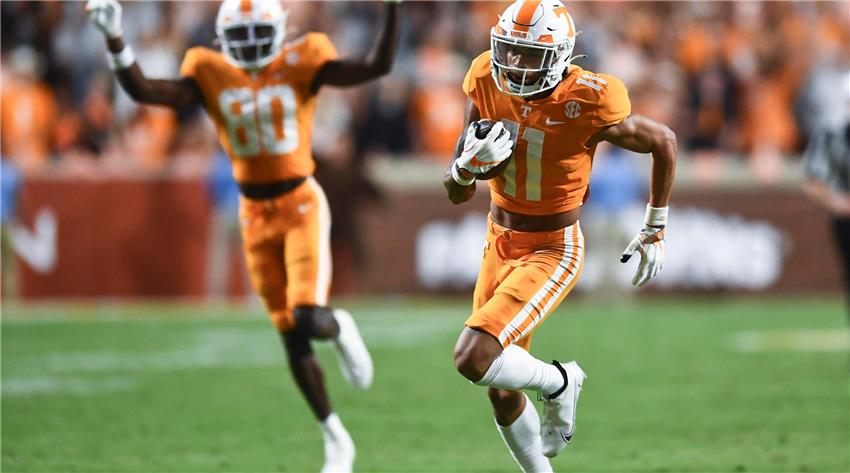
How do Injuries Affect NFL Draft Position?
In the high-stakes arena of the NFL draft, an athlete's health and recovery strategy can be as pivotal as their raw talent.
We chatted with Rolflex, a team of professional athletic trainers and physical therapists, to get their input on how injuries can affect a player’s draft position in the NFL draft. Their innovative arm & leg massager is used in several NFL locker rooms around the league, as well as the NBA, NHL, and MLB, to enhance flexibility, alleviate muscle soreness, and elevate athletic performance – they are experts in injuries & recovery for professional athletes.
This article will explore the nuanced ways injuries influence NFL draft positions, shining a light on how draft position has been affected in the past by notable injuries.
The Impact of Injuries on NFL Draft Stock
It's fair to say that injuries present quite a unique paradox in the NFL draft. On one hand, there's a notable risk associated: not fully healed injuries or the potential for re-injury could feasibly lead to long-term damage. On the other hand, a player that successfully recovers displays resilience—an attribute that teams highly value.
There's a common perception, admittedly a logical one, that a history of injuries may reduce a player's draft stock. A serious injury can scare teams away from a high draft pick. They worry about the potential financial losses if the player can't deliver due to recurring injury issues.
Factors Considered by Teams when Evaluating Injured Players
Seriousness of the Injury is often the first and most pivotal factor NFL teams evaluate. Teams may be hesitant to draft players with significant injuries, fearing potential obstacles in their career development or even premature retirement.
For instance, Jaylon Smith, a prospective top-10 pick in the 2016 NFL Draft, slid down to the second round after suffering a severe knee injury. Now, it should be noted that each injury is unique, and it's essential to not rush to conclusions. A less severe injury might not significantly impact the player's drafting position.
The Position a player occupies can also play a significant role. Some positions, such as running backs or wide receivers, require exceptional speed and agility. In these positions, even a slight physical setback could significantly hinder a player's performance. It's also crucial to note the differences in physical demands between positions, as an injury affection a certain skill could be more impactful for some roles than others.
Recovery Progress is also a major consideration when a player is injured. Teams are keen to know how far along a player is on their recovery journey. If the player is projected to have a long recovery time, it could potentially deter teams from drafting them early.
A clear understanding of their Rehabilitation Plan and commitment to the recovery process can be seen as a positive attribute. Players like Todd Gurley and Adrian Peterson, despite experiencing significant injuries, showed impressive resilience and dedication to their rehab processes. These traits speak to a player's mental toughness, an asset that can be just as appealing to teams as physical prowess.
At the end of the day, the ultimate deciding factor rests with Individual Team Evaluations. Every team has its own unique perspective on player evaluation, placing different degrees of importance on factors such as a player's injury history, position, and recovery potential.
When contemplating these considerations, it's evident that injuries certainly influence the NFL draft process; however, by no means guarantee a player's success or failure. In this high-stakes world, all variables are intertwined and every decision is a calculated risk.
Notable Cases of Players Overcoming Injuries
As we dive deeper into our discussion on how injuries affect NFL drafts, it's crucial to consider cases where players have overcome their injuries and excelled.
Adrian Peterson, a versatile player known for his remarkable toughness, suffered a severe ACL and MCL tear in December 2011. His recovery was nothing short of exceptional. Peterson returned to the field less than a year later, hitting the ground running with a 2,097-yard season - just short of the NFL single-season rushing record. Peterson's comeback emphasized the significance of individual's resilience and commitment to recovery.
Similarly, Todd Gurley faced a similar predicament. Gurley, considered the best running back in his draft class, tore his ACL during his last season at Georgia. The injury could've severely hurt his draft prospects. However, the Rams picked Gurley 10th overall, banking on his talent and recovery commitment. Gurley's example underlines how talent and mental toughness could triumph over an injury scare.
We should also highlight the case of Tom Brady. Though not exactly a draft-related issue, Brady, a 6th round pick in the 2000 draft, suffered a major setback in 2008 with an ACL and MCL tear. This could've derailed his career. Yet, he bounced back with full force and became one of the most celebrated quarterbacks in NFL history.
Looking at these examples, it's clear that athleticism, drive, and dedication can overshadow injury concerns in many instances. In the next section, let's delve into another critical factor when considering injured players - the inherent risk and reward calculation involved in drafting these players.
Strategies for Injured Players to Improve Draft Position
Injury setbacks shouldn't spell doom for aspiring NFL players. Various strategies provide avenues for these athletes to enhance their draft position. Adrian Peterson, Todd Gurley, and Tom Brady are prime examples of individuals who turned challenges into triumphs.
Develop and Demonstrate Resilience
Players who've experienced injuries can turn their predicament into an opportunity to impress potential teams with their resilience. Overcoming adversity is a critical attribute in the NFL, and returning stronger from injury sends a powerful message to scouts. Shows of strength and willpower, both physically and mentally, can impact the perception of the player beyond their injury.
Undergo Thorough Rehabilitation
Effective, thorough rehabilitation after an injury is crucial. We can't stress enough the importance of showing potential teams that the player is fully recovered and ready to perform at a high level. It's not just about getting back on the field; it's about demonstrating the ability to compete at pre-injury standards.
Highlight Past Performance
Past performance remains an invaluable asset when it comes to the draft. It's essential for injured players to ensure scouts and teams remember their prior achievements. This is where game highlights, awards, and standout stats come into play. High-level performances pre-injury offer a snapshot of a player's potential once fully healed.
Keep Communication Lines Open
Clear, proactive communication with potential teams can dispel any fears or doubts surrounding an injury. This involves supplying up-to-date medical reports, rehabilitation progress overviews, and demonstrating a proactive approach to recovery.
Maintain Fitness Levels
Injured players must work diligently to maintain the best possible fitness level, within the constraints of their recovery. Keeping in shape demonstrates dedication and reduces the transition period post-recovery. So, even while injured, training is an integral part of a player's routine.
We believe that injured players have the power to shape their draft narratives by applying these strategies. Whether it's cultivating resilience, undergoing comprehensive rehab, or leveraging past performances, the potential to influence draft decisions is certainly within reach.
We've seen that injuries don't have to spell the end of a promising NFL draft position. It's all about how players handle their injuries and communicate their progress. With resilience, comprehensive rehab, and maintaining fitness levels, players can still secure a good draft position. Our examples, Adrian Peterson, Todd Gurley, and Tom Brady, have shown that it's possible to turn injury challenges into triumphs.
